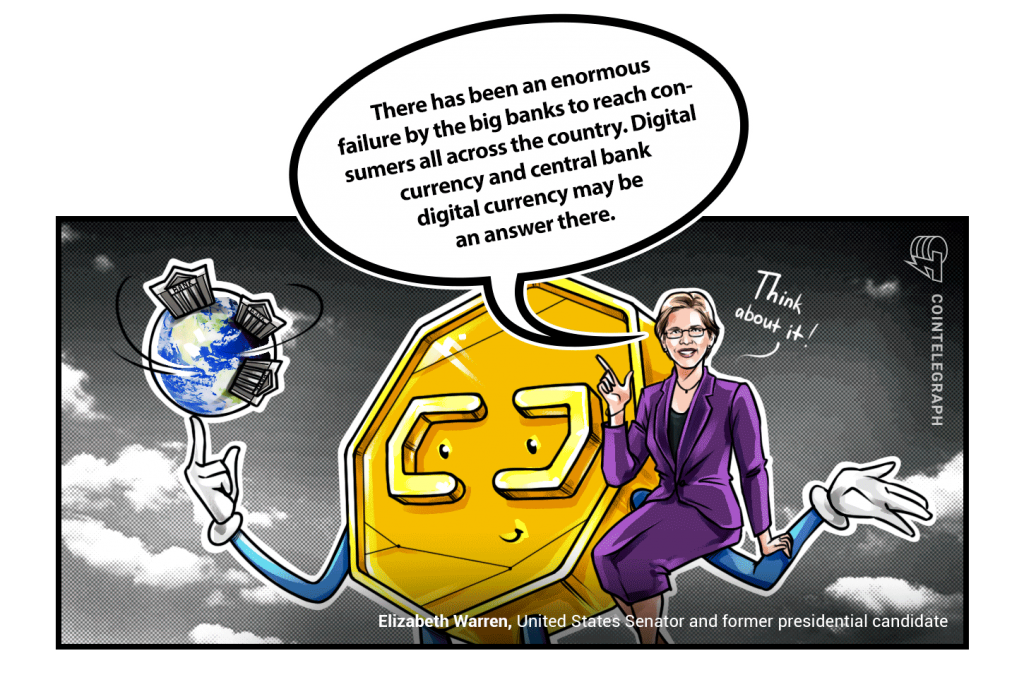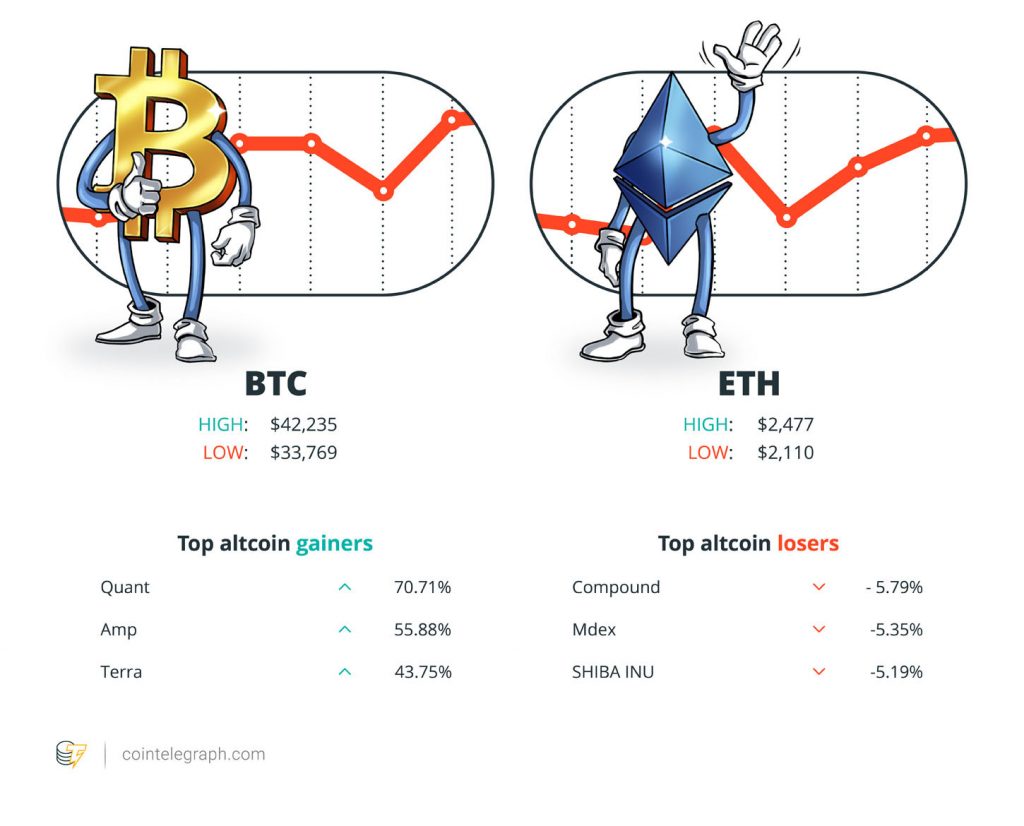Coming every Saturday, Hodler’s Digest will help you track every single important news story that happened this week. The best (and worst) quotes, adoption and regulation highlights, leading coins, predictions and much more — a week on Cointelegraph in one link.
Top Stories This Week
Amazon plans to accept Bitcoin payments this year, claims insider
The crypto community was going wild at the beginning of this week after rumors circulated that Amazon was planning to accept Bitcoin payments.
The rumors started after Amazon posted a job opening for a digital currency and blockchain product lead on July 22. Four days later, an anonymous source within Amazon reportedly told London business newspaper City A.M. that the e-commerce giant was planning to start accepting Bitcoin (BTC) payments by the end of 2021.
“This isn’t just going through the motions to set up cryptocurrency payment solutions at some point in the future — this is a full-on, well-discussed, integral part of the future mechanism of how Amazon will work,” the source told City A.M., according to a report published on Sunday.
Chinese crypto journalist Colin Wu attributed Monday’s surging market action, during which Bitcoin gained roughly 15% in less than three hours, to Amazon’s rumored plans.
How wrong that very self-assured sounding quote from an unnamed source turned out to be after the multinational giant refuted the speculation two days later.
“Notwithstanding our interest in the space, the speculation that has ensued around our specific plans for cryptocurrencies is not true,” a spokesperson said.
Bitcoin struggles at $40K after ‘most confusing’ Jerome Powell press conference
Bitcoin rose above $40,000 on July 29, a day after the Federal Reserve hinted that it was getting closer to winding down its asset purchasing program that has boosted the economic recovery of the United States.
The digital gold previously approached $41,000 ahead of the critical Fed update. Unsurprisingly, it started losing upward momentum after the Federal Open Market Committee released its policy statement, followed by a press conference helmed by the Fed’s chairman, Jerome Powell.
Powell had previously said that the Fed’s asset purchases would continue until it sees “substantial further progress” in the U.S. economic recovery. However, for a while, it was unspecified as to what that actually meant, and Powell finally cleared that up after being questioned in a July 28 press conference.
Turns out that “substantial further progress” means strong labor numbers and gains towards maximum employment.
Maximum employment refers to the highest level of achievable employment that the economy can sustain while maintaining a stable inflation rate. Given the rise of inflation and the decline of jobs due to the pandemic, the Fed’s maximum employment targets may need further clarification.
BTC investors have been closely monitoring how soon the central bank might unwind its $120-billion-per-month bond-buying program due to its role in aiding the Bitcoin bull market.
Binance cuts withdrawal limits, rolls out tax reporting tool
Following increased scrutiny aimed at Binance from governments and financial institutions across the globe, the world’s biggest crypto exchange has been working on regulatory compliance.
In the latest attempt to maintain dialogue with global regulators, Binance introduced withdrawal limits and a new tax reporting system.
The company officially announced on July 27 a major update to its Know Your Customer policies, significantly reducing maximum withdrawal amounts for users who have not completed full identity verification.
Effective from the date of the announcement, new Binance accounts whose users have completed only basic account verifications will be unable to withdraw more than 0.06 Bitcoin per day, worth roughly $2,329 at the time of writing. Previously, the maximum daily withdrawal amount was capped at 2 BTC, or about $77,661.
On July 30, the platform also announced that it will be shutting down its crypto derivatives trading for customers across Europe, first starting with Germany, Italy and the Netherlands.
This week, Changpeng Zhao, the CEO and founder of Binance, said he wanted the crypto exchange to work with local regulators as it establishes regional headquarters.
Zhao, also known as CZ, hinted that Binance would depart from its decentralized approach to finance and that wanted the exchange to coordinate with regulators as the company expands.
“We want to be licensed everywhere,” CZ said. “From now on, we’re going to be a financial institution.”
MicroStrategy pledges to buy more BTC despite paper loss on its holdings of $424.8M in Q2
MicroStrategy pledged to buy more Bitcoin despite reporting impairment losses of $424.8 million in Q2, after it stated that it was “pleased” by the results of its digital asset strategy in its July 29 Q2 report.
At a first glance, it appeared that MicroStrategy had lost the plot, as the Q2 report showed that as of June 30, MicroStrategy held an approximate 105,085 BTC with a carrying value of $2.051 billion, at an impairment loss of $689.6 million since acquisition. The average carrying amount per Bitcoin was an estimated $19,518.
Earlier this week Elon Musk’s Tesla also published a Q2 report which showed a $23 million impairment loss on its Bitcoin holdings.
As both firms categorize Bitcoin as an “intangible asset,” accounting rules mandate that they must report an impairment loss when the asset’s price drops below its cost basis. However, they are not required to report price appreciation in the specified asset until the position is realized through a sale.
The digital asset figures were calculated using Generally Accepted Accounting Principles (GAAP) — a collection of commonly accepted accounting rules used for financial reporting. The firm also provided non-GAAP calculations, which in this report exclude the “impact of share-based compensation expense and impairment losses and gains on sale from intangible assets.”
The non-GAAP figures paint a different picture for MicroStrategy’s digital asset holdings, with the BTC cost basis at $2.741 billion but its market value is $3.653 billion, which reflects an average cost per BTC at $26,080 and a market price of $34,763 as of June 30.
This may be the reason why MicroStrategy CEO Michael Saylor continues to double down on BTC and pursue the hodl modl.
PayPal set to launch crypto trading in the UK and may embrace DeFi
On July 30, it was revealed that global payments platform PayPal is looking to expand its crypto trading services to the U.K. market, with the firm also revealing that it is looking at embracing DeFi.
According to the company’s second-quarter earnings call on July 28, PayPal was very keen to pat itself on the back after the firm noted how well it performed during Q2 with its crypto trading services. CEO Dan Schulman stated that the U.K. is likely to be the next country where crypto trading is offered, and “maybe even next month.”
Speaking on DeFi, Schulman suggested that PayPal was looking into “what the next generation of the financial system looks like” and how to integrate smart contracts and decentralized apps into the platform:
How can we use smart contracts more efficiently? How can we digitize assets and open those up to consumers that may not have had access to that before? There are some interesting DeFi applications as well. And so we are working really hard.
Schulman also revealed that revenues of PayPal-owned mobile payment service Venmo grew by 183% year-over-year and that there has been strong adoption and trading of crypto on Venmo as well. Venmo launched crypto trading services to an estimated 70 million users in mid-April.
Paypal’s 2020 entrance into crypto was widely cited as one of the early catalysts for last year’s meteoric bull run, with the firm first announcing it would introduce U.S. crypto trading service in November.
Winners and Losers
At the end of the week, Bitcoin is at $38,906 Ether at $2,357 and XRP at $0.72 The total market cap is at $1.53 trillion, based on CoinMarketCap data.
Among the biggest 100 cryptocurrencies, the top three altcoin gainers of the week are Quant (QNT) at 70.71%, Amp (AMP) at 55.88%, and Terra(LUNA) at 43.75%.
The top three altcoin losers of the week are Compound (COMP) at -5.79%, Mdex (MDX) at -5.35%, and Shiba Inu (SHIB) at -5.19%.
For more info on crypto prices, make sure to read Cointelegraph’s market analysis.
Most Memorable Quotations
I think central bank digital currencies were concocted in hell by Satan himself.
Rich Checkan, president of Asset Strategies International
You even have some in the House that sit not too far from me on the House Financial Services Committee that would call blockchain basically a financial 9/11.
Representative Ted Budd of North Carolina, member of the House Financial Services Committee and Congressional Blockchain Caucus
They claim to enable ‘transparency.’ Their backers talk about the ‘democratization of banking.’ There’s nothing ‘democratic’ or ‘transparent’ about a shady, diffuse network of online funny money.
Sherrod Brown, United States Democratic Senator
Spending America deeper into a hole is a stupid, inflationary & altogether undesirable way to drive ppl to digital assets. I want USD to continue as the world’s reserve currency. We need to reign in spending & support financial innovation on US soil.
Cynthia Lummis, United States Republican Senator
When the scourge of the COVID-19 pandemic hit and forced many economies into partial and total lockdowns, it reinforced the need to pursue digitization.
Mahamudu Bawumia, Vice President of Ghana
“There has been an enormous failure by the big banks to reach consumers all across the country. Digital currency and central bank digital currency may be an answer there.”
Elizabeth Warren, United States Senator and former presidential candidate
We continue to be pleased by the results of the implementation of our digital asset strategy. Our latest capital raise allowed us to expand our digital holdings, which now exceed 105,000 bitcoins. Going forward, we intend to continue to deploy additional capital into our digital asset strategy.
Michael Saylor, MicroStrategy CEO
Bitcoin Mining is the most ESG friendly business in the world. Bitcoin miners are 24/7 consumers of energy that can be placed near wasted power assets. Bitcoin miners help energy companies plan/control their demand — this brings in revenue to divest from coal and invest in renewable energy assets.
Will Szamosszegi, CEO and founder of Sazmining Inc., from Markets Pro Q&A
Prediction of the Week
Ethereum price can hit $14K if the March 2020 chart fractal holds
Now that it looks like the cryptomarkets are picking back up, numerous bullish predictions are beginning to resurface. The recent flip in sentiment makes one wonder whether the highly coveted “moon” may once again be in sight.
Earlier this week TradingView user “TradingShot” spotted an extremely bullish fractal on the Ethereum chart which indicated that ETH may close 2021 above $14,000.
The Ethereum fractal involves three technical indicators: a 50-day simple moving average (SMA), a Fibonacci channel and a relative strength index.
Ether closed above its 50-day SMA in July 2021, the first time since the May 2021 bearish buzzkill market correction. As TradingShot pointed out, breaking above the 50-day SMA has historically predicted bull runs. For instance, a run-up above the 50-day SMA in April 2020 took the ETH/USD exchange rate from around $170 to over $500 in September 2020 — in only 137 days.
A word of caution, however, based on this author’s 20-second analysis: The last time ETH hit all-time highs around the $4,000 to $4,300 price range in mid-May, it stayed there for roughly five days before crashing sharply and forcing the bulls into hibernation.
FUD of the Week
Warren urges Treasury Secretary Yellen to combat rising crypto threats
Earlier this week, U.S. Democratic Senator and anti-crypto proponent Elizabeth Warren called on Treasury Secretary Janet Yellen and other regulators to develop a “comprehensive and coordinated” framework for addressing risks in the cryptocurrency market.
“As the demand for cryptocurrencies continues to grow and these assets become more embedded in our financial system, consumers, the environment, and our financial system are under growing threats,” Warren said in a letter to Yellen.
According to Warren, an under-regulated cryptocurrency market poses a significant risk to major financial players, such as hedge funds and banks. What Warren is forgetting, however, is that hedge funds and banks are usually bailed out with taxpayer money in times of financial crises, so they really have nothing to worry about.
The senator is renowned for pushing back against cryptic currencies or whatever they are called, and has described assets like Dogecoin as a “fourth-rate alternative to real currency.”
It appears she hasn’t seen enough memes from the DOGE community to be swayed on the value of Dogecoin as of yet.
IMF issues veiled warning against El Salvador’s Bitcoin Law
The International Monetary Fund, or IMF, warned this week that the consequences of a country adopting Bitcoin as a national currency “could be dire.”
The IMF didn’t specify which country it was talking about, but one thinks it may be El Salvador — the first nation to adopt Bitcoin as a national currency.
According to assertions from IMF marketing department financial counselor and director Tobias Adrian and legal department general counsel and director Rhoda Weeks-Brown,countries adopting cryptocurrencies as national currencies or “granting crypto assets legal tender status” risks domestic prices becoming highly unstable.
They also emphasized that the assets could be used contrary to Anti-Money Laundering and financing of terrorism measures, in addition to having issues surrounding macroeconomic stability and the environment.
Law professor calls for crypto mining regulation during US Senate hearing
Just as everyone was getting excited about the majority of the global BTC hash rate migrating out of China to the U.S., one little-known law expert has to come to ruin it all.
Professor Angela Walch of the St. Mary’s University School of Law attended the July 27 crypto hearing before the U.S. Senate Committee on Banking, Housing and Urban Affairs to call for stricter regulations on people who keep the crypto sector moving smoothly.
Thankfully, she wasn’t asking for a China-esque ban and, in addressing the committee, Walch claimed that miners held “meaningful power” over the way blockchain networks operate. She asserted that they can potentially exploit the role of transaction ordering, which could become a “major issue” for cryptocurrencies.
In stressing the point, professor Walch likened the miner extractable value paradigm — where miners earn more profits from ordering transactions in a certain way — as being akin to a “bribe.”
She may have a point, though — sometimes it does feel like you’re bribing someone to get an Ethereum transaction through the books when tokenized cats clog up the network and send gas fees to the moon.
Best Cointelegraph Features
Blockchain tech is holding NFTs back because of these three design flaws
Three design flaws in blockchain tech are holding the NFT sector back — and they need to be tackled for it to reach its full potential.
Powers On… Why the fear of ICO enforcement and liability is coming to an end
Eleven class actions against crypto firms and their founders started with a bang and will end with a whimper — as they should.
Traders anticipate ‘DeFi Summer 2.0’ after TVL and token prices rise
A rally in blue-chip DeFi tokens and the sector’s rising total value locked has traders hopeful that a prolonged rally will take place.
Editorial Staff
Saylor falls for fake Trump news, Kraken restructures, and more: Hodler’s Digest, Oct. 27 – Nov. 2
MicroStrategy’s Michael Saylor falls for a post about Donald Trump’s position on taxing crypto, Kraken declares “new day.” Hodler’s Digest
Read moreSecrets of crypto founders under 25 who are making bank
Too young to be taken seriously, too bold to be ignored. Meet some of the young crypto entrepreneurs fighting to make their mark in crypto.
Read moreChina mocks US crypto policies, Telegram’s new dark markets: Asia Express






